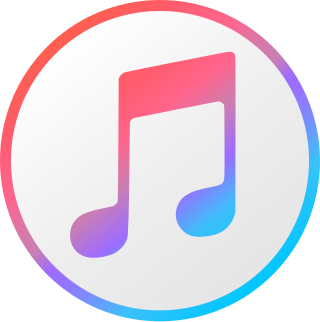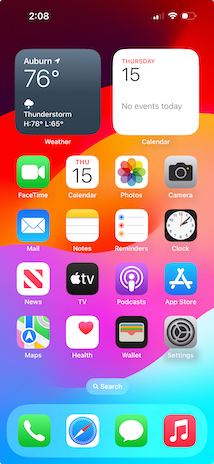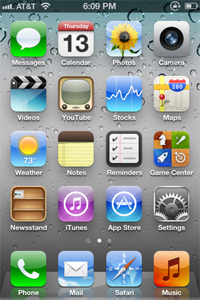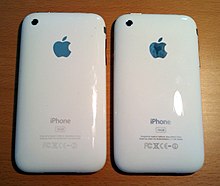
iTunes is a software program that acts as a media player, media library, mobile device management utility, and the client app for the iTunes Store. Developed by Apple Inc., it is used to purchase, play, download and organize digital multimedia on personal computers running the macOS and Windows operating systems, and can be used to rip songs from CDs as well as playing content from dynamic, smart playlists. It includes options for sound optimization and wirelessly sharing iTunes libraries.

The iTunes media platform was first released by Apple in 2001 as a simple music player for Mac computers. Over time, iTunes developed into a sophisticated multimedia content manager, hardware synchronization manager and e-commerce platform. iTunes was finally discontinued for new Mac computers in 2019, but is still available and supported for Macs running older operating systems and for Windows computers to ensure updated compatibility for syncing with new releases of iOS devices.

The iPhone is a line of smartphones produced by Apple Inc. that use Apple's own iOS mobile operating system. The first-generation iPhone was announced by then–Apple CEO Steve Jobs on January 9, 2007. Since then, Apple has annually released new iPhone models and iOS updates. As of November 1, 2018, more than 2.2 billion iPhones had been sold.

The iPod Touch is a discontinued line of iOS-based mobile devices designed and formerly marketed by Apple Inc. with a touchscreen-controlled user interface. As with other iPod models, the iPod Touch can be used as a portable media player and a handheld gaming device, but can also be used as a digital camera, a web browser, for email and messaging. It is nearly identical in design to the iPhone, and can run most iPhone third-party apps from the App Store, but it connects to the Internet only through Wi-Fi and uses no cellular network data, as it lacks a cellular modem.

iOS is a mobile operating system developed by Apple Inc. exclusively for its smartphones. It was unveiled in January 2007 for the first-generation iPhone, launched in June 2007.

The iPhone 3G is a smartphone designed, developed, and marketed by Apple Inc. It is the second generation of iPhone, successor to the original iPhone, and was introduced on June 9, 2008, at the WWDC 2008 which took place at the Moscone Center in San Francisco.
iOS is a mobile operating system developed by Apple Inc. and was first released as iPhone OS in June 2007, coinciding with the launch of the first generation iPhone. iPhone OS was renamed iOS following the release of the iPad, starting with iOS 4. With iOS 13, Apple began offering a separate operating system, iPadOS, for the iPad. iOS is also the foundation of the newer audioOS and tvOS, and shares some of its code with macOS. New iOS versions are released every year alongside new iPhone models. From its launch in 2007 until 2010, this occurred in June or July, since then, new major versions are released in September or October. Since the launch of the iPhone in June 2007, there have been 17 major releases of iOS. The current major version of iOS is iOS 17, released on September 18, 2023.
iOS jailbreaking is the use of a privilege escalation exploit to remove software restrictions imposed by Apple on devices running iOS and iOS-based operating systems. It is typically done through a series of kernel patches. A jailbroken device typically permits root access within the operating system and provides the right to install software unavailable through the App Store. Different devices and versions are exploited with a variety of tools. Apple views jailbreaking as a violation of the end-user license agreement and strongly cautions device owners not to try to achieve root access through the exploitation of vulnerabilities.

The iPhone 4 is a smartphone that was designed, developed, and marketed by Apple Inc. It is the fourth generation of the iPhone lineup, succeeding the iPhone 3GS and preceding the 4S. Following a number of notable leaks, the iPhone 4 was first unveiled on June 7, 2010, at Apple's Worldwide Developers Conference in San Francisco, and was released on June 24, 2010, in the United States, United Kingdom, France, Germany, and Japan. The iPhone 4 introduced a new hardware design to the iPhone family, which Apple's CEO Steve Jobs touted as the thinnest smartphone in the world at the time; it consisted of a stainless steel frame which doubled as an antenna, with internal components situated between two panels of aluminosilicate glass. The iPhone 4 introduced Apple's new high-resolution "Retina Display", while maintaining the same physical size and aspect ratio as its precursors, Apple's A4 system-on-chip, along with iOS 4—which notably introduced multitasking functionality and app folders. It was the first iPhone at the time to include a front-facing camera, which made possible Apple's new FaceTime video chat service, and the first to be released in a version for CDMA networks, ending AT&T's period as the exclusive carrier of iPhone products in the United States.

iOS 4 is the fourth major release of the iOS mobile operating system developed by Apple Inc., being the successor to iPhone OS 3. It was announced at the Apple Special Event on April 8, 2010, and released on June 21, 2010. iOS 4 was the first version branded as "iOS" rather than "iPhone OS", due to the release of the iPad. It was succeeded by iOS 5 on October 12, 2011.

The iPhone is the first iPhone model and the first smartphone designed, developed, and marketed by Apple Inc. After years of rumors and speculation, it was officially announced on January 9, 2007, and was released in the United States on June 29, 2007.

The iPad 2 is a tablet designed, developed and marketed by Apple Inc. Compared to the first iPad, as the second model in the iPad line, it gained a faster dual core A5 processor, a lighter build structure with a flat, rather than curved, back, and was the first iPad to feature VGA front-facing and 720p rear-facing cameras designed for FaceTime video calling.

The iPhone 4s is a smartphone that was designed, developed, and marketed by Apple Inc. It is the fifth generation of the iPhone, succeeding the iPhone 4 and preceding the iPhone 5. It was announced on October 4, 2011, at Apple's Cupertino campus, and was the final Apple product announced in the lifetime of former Apple CEO and co-founder Steve Jobs, who died the following day.

iOS 5 is the fifth major release of the iOS mobile operating system developed by Apple Inc., being the successor to iOS 4. It was announced at the company's Worldwide Developers Conference on June 6, 2011, and was released on October 12, 2011. It was succeeded by iOS 6 on September 19, 2012.

The first-generation iPad is a tablet computer designed and marketed by Apple Inc. as the first device in the iPad lineup of tablet computers. The device features an Apple A4 SoC, a 9.7 in (250 mm) touchscreen display, and, on certain variants, the capability of accessing cellular networks. Using the iOS operating system, the iPad can play music, send and receive email and browse the web. Other functions, which include the ability to play games and access references, GPS navigation software and social network services can be enabled by downloading apps.

The fourth generation iPod Touch is a multi-touch mobile device designed and marketed by Apple Inc. with a touchscreen-based user interface. The successor to the 3rd-generation iPod Touch, it was unveiled at Apple's media event on September 1, 2010, and was released on September 12, 2010. It is compatible with up to iOS 6.1.6, which was released on February 21, 2014.

iPhone OS 2 is the second major release of the iOS mobile operating system developed by Apple Inc., being the successor to iPhone OS 1. It was the first version of iOS to support third-party applications via the App Store. iPhone OS 2.2.1 is the final version of iPhone OS 2. It was succeeded by iPhone OS 3 on June 17, 2009.

iPhone OS 3 is the third major release of the iOS mobile operating system developed by Apple Inc., succeeding iPhone OS 2. It was announced on March 17, 2009, and was released on June 17, 2009. It was succeeded by iOS 4 on June 21, 2010, dropping the "iPhone OS" naming convention.

The third generation iPod Touch is a multi-touch mobile device designed and marketed by Apple Inc. with a touchscreen-based user interface and is the successor to the 2nd-generation iPod Touch. It was unveiled and released at Apple's media event on September 9, 2009.
The iPhone's hardware is designed by Apple Inc. Apple directly sub-contracts hardware production to external OEM companies, maintaining a high degree of control over the end product.

















